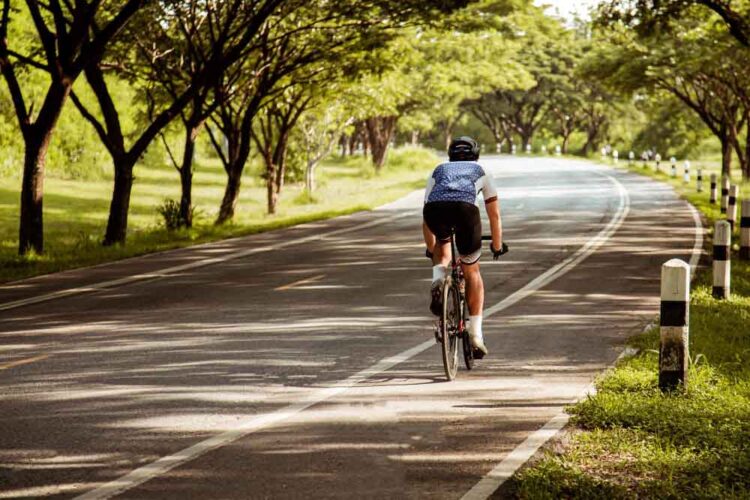Are you a beginner cyclist eager to hit the road? Before you embark on your cycling journey, ask yourself this: do you prioritize your safety? While the thrill of cycling is undeniable, it’s crucial to understand the importance of road cycling safety and safe cycling practices. This comprehensive guide is here to equip you with the knowledge and tips you need to ensure a safe and enjoyable ride.
Key Takeaways:
- Understanding and implementing road cycling safety measures is crucial for beginner cyclists.
- Safe cycling practices can significantly reduce the risk of accidents and injuries on the road.
- By following the recommendations in this guide, beginners can confidently navigate various cycling environments.
- Having the right equipment and maintaining it properly is an essential aspect of cycling safety.
- Developing proper riding techniques and observing traffic laws are key to staying safe while cycling.
Essential Equipment for Cycling Safety
When it comes to cycling safety, having the right equipment is crucial. By investing in the necessary gear and following bicycle safety rules, you can significantly reduce the risk of accidents on the road. In this section, we will discuss the essential cycling safety gear that every cyclist should have.
Helmets
Wearing a helmet is one of the most important bicycle safety rules. A helmet protects your head in case of a fall or collision, reducing the risk of severe head injuries. Make sure your helmet fits properly and is certified by relevant safety standards.
Reflective Clothing
Another essential piece of cycling safety gear is reflective clothing. Wearing brightly colored or reflective clothing improves visibility, especially in low-light conditions. This allows motorists and other road users to see you more easily, reducing the chances of accidents.
Lights and Mirrors
Equipping your bicycle with lights and mirrors is crucial for safe cycling practices. Front and rear lights make you more visible to others on the road, especially at night or in dark conditions. Mirrors help you stay aware of your surroundings, allowing you to anticipate potential hazards.
Maintaining Your Bicycle
Ensuring that your bicycle is in good working condition is an essential part of cycling safety. Regularly check and maintain your bike’s brakes, tire pressure, and chain. Keep your bike clean and lubricate moving parts to prevent malfunctions that can lead to accidents.
Remember, following bicycle safety rules and having the right cycling safety gear are crucial for a safe riding experience. Now, let’s explore the riding techniques for safe cycling in the next section.
Riding Techniques for Safe Cycling
Developing proper riding techniques is crucial for staying safe while cycling. By following road bike safety etiquette and bike safety precautions, every cyclist can minimize the risk of accidents and injuries. Here are some essential tips to keep in mind:
1. Signaling
Signaling is an effective way to communicate your intentions to other road users. Always use hand signals to indicate your turns and lane changes. This helps drivers and pedestrians anticipate your actions, reducing the chances of sudden collisions. Remember to signal well in advance, giving others enough time to react.
2. Maintaining a Safe Distance
Keep a safe distance from vehicles to avoid accidents. Ideally, give at least three feet of space between your bike and passing cars. This provides a buffer zone, allowing you to maneuver safely and react to unexpected situations. Avoid riding in the blind spots of larger vehicles, such as trucks or buses, as they may not see you.
3. Observing Traffic Laws
Adhering to traffic laws is essential for your safety as a cyclist. Obey traffic lights, stop signs, and yield to pedestrians. Always ride in the same direction as traffic, staying on the right side of the road. This ensures that motorists can anticipate your movements and helps prevent collisions.
“Safe cycling requires a combination of knowledge, skill, and vigilance.” – John Forester
Following these road bike safety etiquette and bike safety precautions will significantly reduce the risk of accidents and injuries. As a cyclist, it’s your responsibility to prioritize safety and be mindful of your surroundings. By implementing these techniques, you can confidently enjoy your ride while staying safe on the road.

| Riding Techniques for Safe Cycling | Summary |
|---|---|
| 1. Signaling | Use hand signals to indicate turns and lane changes |
| 2. Maintaining a Safe Distance | Give at least three feet of space between your bike and other vehicles |
| 3. Observing Traffic Laws | Follow traffic lights, stop signs, and ride in the same direction as traffic |
Cycling Safety Tips for Different Environments
When it comes to cycling, safety should always be a top priority, regardless of the environment you’re riding in. Whether you’re navigating busy city streets, tackling rugged mountain trails, or cycling through urban areas, it’s crucial to be prepared and aware of the unique challenges and hazards each setting presents. By following these cycling safety tips, you can ensure a safe and enjoyable riding experience in any environment.
City Cycling Safety
City cycling can be exhilarating, but it’s essential to take precautionary measures to stay safe amidst traffic and pedestrians. Here are some city cycling safety tips:
- Always wear a helmet and make sure it fits properly.
- Obey traffic laws and signals.
- Use hand signals to indicate your intentions to drivers.
- Stay visible by wearing bright and reflective clothing.
- Be cautious at intersections and watch out for turning vehicles.
Remember, defensive riding is key in the city, so anticipate and be prepared for unexpected situations.
Mountain Biking Safety
Mountain biking offers an exciting challenge, but it also comes with its own set of risks. To stay safe during your off-road adventures, consider these mountain biking safety tips:
- Always wear appropriate safety gear, including a helmet, knee and elbow pads, and gloves.
- Inspect your bike before every ride, ensuring it’s in good working condition.
- Ride within your skill level and be aware of your surroundings.
- Stay on designated trails and respect the natural environment.
- Carry essential tools, water, and first aid supplies.
By being prepared and respecting the trails, you can enjoy the thrills of mountain biking while minimizing the risks.
Urban Cycling Tips
Urban cycling combines the challenges of city cycling with the unique characteristics of urban environments. Stay safe by following these urban cycling tips:
- Plan your route in advance, considering bike lanes and quieter streets.
- Stay alert and watch out for opening car doors and pedestrians.
- Avoid riding in the blind spots of larger vehicles.
- Use bike lights and reflective gear, particularly when riding at night.
- Lock your bike securely when parking it.
Urban areas can be busy and hectic, so it’s crucial to stay vigilant and take proactive measures to ensure your safety.
By following these cycling safety tips tailored for different environments, you can confidently navigate city streets, conquer mountain trails, and ride through urban areas with peace of mind. Remember, being prepared, aware, and respectful of the rules and challenges specific to each setting is key to enjoying a safe and rewarding cycling experience.
Conclusion
Prioritizing cycling safety is crucial for both beginners and experienced riders. By following the essential bike safety tips and practices outlined in this guide, cyclists can significantly reduce their risk of accidents and injuries.
Remember to always wear the proper safety gear, including helmets and reflective clothing, to enhance visibility on the road. Regularly maintain your equipment, such as checking tire pressure and brakes, to ensure optimal performance and safety. Additionally, practice safe riding techniques, such as signaling, maintaining a safe distance from vehicles, and obeying traffic laws.
By implementing these cycling safety tips in your riding routine, you can confidently hit the road and enjoy your cycling journey with peace of mind. Stay safe, be aware, and happy cycling!














